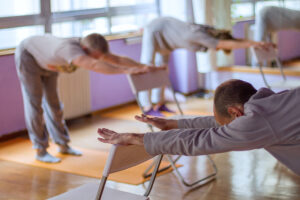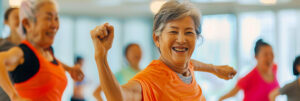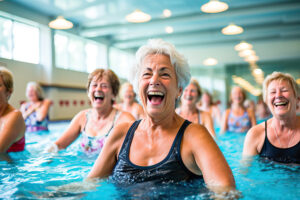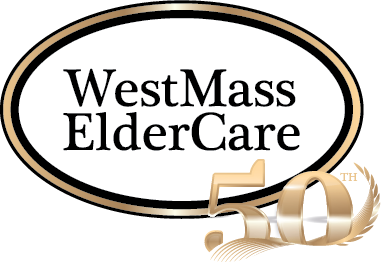 As the leaves turn golden and the crisp autumn air sets in, it’s the perfect time to revitalize our fitness routines. Fall is a season of change, and it can be an excellent opportunity to embrace new and adaptive exercise routines, especially for older adults and individuals with disabilities. Engaging in regular physical activity is crucial for maintaining health, improving mobility, and enhancing overall well-being. Let’s explore some adaptive exercises like chair yoga, Zumba Gold, and other adapted exercise routines that can make fitness accessible and enjoyable for everyone.
As the leaves turn golden and the crisp autumn air sets in, it’s the perfect time to revitalize our fitness routines. Fall is a season of change, and it can be an excellent opportunity to embrace new and adaptive exercise routines, especially for older adults and individuals with disabilities. Engaging in regular physical activity is crucial for maintaining health, improving mobility, and enhancing overall well-being. Let’s explore some adaptive exercises like chair yoga, Zumba Gold, and other adapted exercise routines that can make fitness accessible and enjoyable for everyone.
The Importance of Adaptive Exercise
Adaptive exercise routines are specifically designed to cater to the needs of individuals with limited mobility or specific health conditions. These routines aim to improve strength, flexibility, balance, and cardiovascular health without putting undue strain on the body. For older adults and individuals with disabilities, adaptive exercises can help in:
- Enhancing physical and mental health
- Reducing the risk of chronic diseases
- Improving mood and reducing anxiety and depression
- Promoting social interaction and community engagement
Chair Yoga: A Gentle Approach to Flexibility and Relaxation
Chair yoga is a fantastic adaptive exercise that brings the benefits of traditional yoga to those who may have difficulty with standard poses or standing for long periods. By using a chair for support, participants can perform a variety of yoga poses that help stretch and strengthen muscles, improve joint health, and enhance overall flexibility.
Benefits of Chair Yoga:
- Increased Flexibility: Gentle stretching improves range of motion and eases muscle tension.
- Enhanced Strength: Holding poses builds muscle strength without high impact.
- Improved Balance: Regular practice can enhance balance and reduce the risk of falls.
- Stress Reduction: Deep breathing and mindfulness techniques promote relaxation and mental clarity.
Simple Chair Yoga Poses to Try:
- Seated Mountain Pose: Sit tall with feet flat on the floor, hands resting on thighs. Engage the core and lengthen the spine.
- Seated Forward Bend: From the seated mountain pose, gently hinge at the hips to bring your chest towards your thighs, reaching your hands towards your feet.
- Seated Twist: Sit tall, place your left hand on the outside of your right thigh, and gently twist to the right, looking over your right shoulder. Repeat on the other side.
- Seated Cat-Cow: Place hands on knees, inhale and arch the back (cow pose), exhale and round the spine (cat pose).
 Zumba Gold: Fun and Fitness for All Abilities
Zumba Gold: Fun and Fitness for All Abilities
Zumba Gold is an adapted version of the popular dance workout, Zumba, designed specifically for older adults and individuals with disabilities. This low-impact exercise program incorporates Latin and international music with easy-to-follow dance moves, making it a fun and effective way to improve cardiovascular health and coordination.
Benefits of Zumba Gold:
- Cardiovascular Health: Engaging in rhythmic movements increases heart rate and improves cardiovascular fitness.
- Coordination and Balance: Dance routines enhance motor skills and balance.
- Social Interaction: Group classes provide a sense of community and opportunity for socialization.
- Mood Enhancement: The energetic music and fun atmosphere boost mood and energy levels.
Other Chair and Adapted Exercise Routines
Beyond chair yoga and Zumba Gold, there are numerous other adaptive exercise routines that cater to varying levels of ability and fitness goals.
Seated Strength Training:
Using resistance bands or light weights, seated strength training exercises can help build muscle and improve bone density. Exercises like seated bicep curls, shoulder presses, and leg lifts can be done safely from a chair.
Chair Aerobics:
Chair aerobics routines incorporate a series of seated movements that elevate heart rate and improve cardiovascular endurance. These routines often include arm raises, leg kicks, and torso twists, all performed while seated.
Tai Chi for Older Adults:
Adapted Tai Chi focuses on slow, deliberate movements and deep breathing. It improves balance, flexibility, and mental clarity. Many Tai Chi programs offer seated options for those with mobility limitations.
 Water Aerobics:
Water Aerobics:
For those who have access to a pool, water aerobics is an excellent low-impact exercise option. The buoyancy of water supports the body, reducing the risk of injury while providing resistance for muscle strengthening and cardiovascular conditioning.
Tips for Getting Started with Adaptive Exercises
- Consult a Healthcare Professional: Before starting any new exercise routine, it’s essential to consult with a healthcare provider, especially if there are existing health conditions.
- Find a Qualified Instructor: Look for instructors certified in adaptive fitness who understand the unique needs of older adults and individuals with disabilities.
- Start Slow: Begin with short sessions and gradually increase the duration and intensity as comfort and fitness levels improve.
- Listen to Your Body: Pay attention to how your body feels during and after exercise. It’s important to avoid pushing too hard and risking injury.
- Stay Consistent: Regular exercise is key to reaping the benefits. Aim to incorporate adaptive exercise routines into your weekly schedule.
Conclusion
Fall is a beautiful season to embrace the transformative power of fitness. Adaptive exercise routines like chair yoga, Zumba Gold, and other chair and adapted exercises provide accessible, enjoyable ways for older adults and individuals with disabilities to stay active and healthy. Consider joining a class or using online resources to practice at home. By incorporating these exercises into daily life, everyone can experience the physical, mental, and emotional benefits of staying fit, regardless of age or ability. So, let’s celebrate the season of change by prioritizing our health and well-being with adaptive fitness for all!


 As the leaves turn golden and the crisp autumn air sets in, it’s the perfect time to revitalize our fitness routines. Fall is a season of change, and it can be an excellent opportunity to embrace new and adaptive exercise routines, especially for older adults and individuals with disabilities. Engaging in regular physical activity is crucial for maintaining health, improving mobility, and enhancing overall well-being. Let’s explore some adaptive exercises like chair yoga, Zumba Gold, and other adapted exercise routines that can make fitness accessible and enjoyable for everyone.
As the leaves turn golden and the crisp autumn air sets in, it’s the perfect time to revitalize our fitness routines. Fall is a season of change, and it can be an excellent opportunity to embrace new and adaptive exercise routines, especially for older adults and individuals with disabilities. Engaging in regular physical activity is crucial for maintaining health, improving mobility, and enhancing overall well-being. Let’s explore some adaptive exercises like chair yoga, Zumba Gold, and other adapted exercise routines that can make fitness accessible and enjoyable for everyone. Zumba Gold: Fun and Fitness for All Abilities
Zumba Gold: Fun and Fitness for All Abilities Water Aerobics:
Water Aerobics: